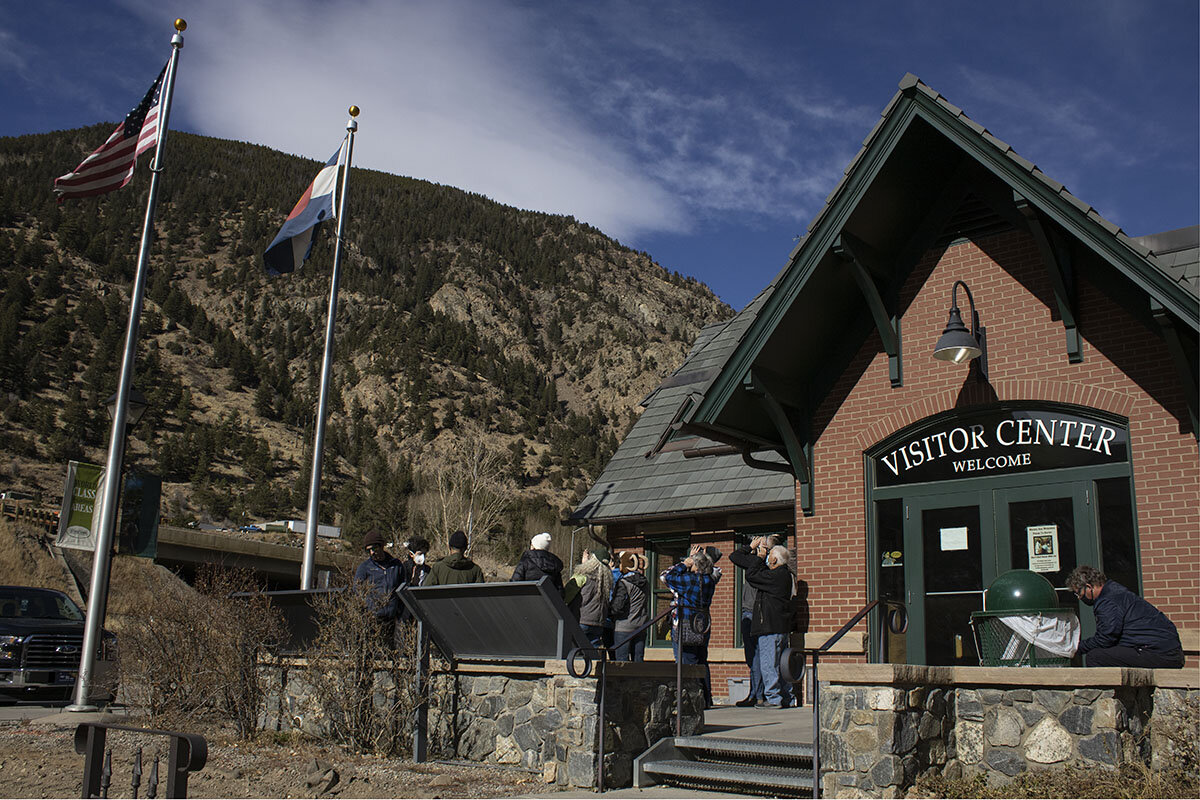Letter from Colorado: Searching for bighorn sheep, finding patience
Loading...
| Georgetown, Colo.
The annual Georgetown Bighorn Sheep Festival in Colorado is back after a pandemic hiatus. It’s an autumn homage to the state animal with curlicue horns. The event syncs with their “rut” – or mating season – when rams head-clash over ewes. Sounds like gunshots, locals say.
The festival offers education while also boosting tourism in a town that’s “kind of like a Rockwell painting,” says Paul Boat, executive director of the Georgetown Trust for Conservation and Preservation, which co-organized the day.
Why We Wrote This
After moving from the East Coast to the Mountain West, one Monitor reporter adjusts to a slower pace. Patience has its rewards – especially outdoors.
To help visitors view the burly herbivores, volunteers like Jane Frobose spread out with binoculars. Until now, that’s one accessory I’d never thought to own.
This summer I moved to Colorado from New York City. In my experience, fauna in Queens was mostly puddle-hopping pigeons and subway rats that drag pizza slices through the filth.
I do miss New York-style pizza, but not my impatience. It accrued over years of city living the way a gait gathers speed down the sidewalk. Patience has its perks as my eyes take more in: spindly wildflowers, tapestries of stars, mountain peaks already glowing with snow. And as the festivities wind down, I even spot two bighorns.
Binoculars burrow into brows as a cluster of Coloradans squint up the slope. The main attraction has yet to show. To be fair, the wind tugging at the brims of baseball caps may explain the absence of the Rocky Mountain bighorn sheep.
“You look for moving rocks,” says volunteer Jane Frobose. Another tip is to spot their rumps – “white like long johns.” One guy outside the visitor center this Saturday morning claims to see them. The rest of us keep waiting, squinting.
The annual Georgetown Bighorn Sheep Festival is back after a pandemic hiatus. It’s an autumn homage to the state animal with curlicue horns. It centers around the local “Georgetown herd,” a hoofed posse of up to 350 sheep that rock-scramble above Interstate 70. The event syncs with their “rut” – or mating season – when rams head-clash over ewes. Sounds like gunshots, locals say.
Why We Wrote This
After moving from the East Coast to the Mountain West, one Monitor reporter adjusts to a slower pace. Patience has its rewards – especially outdoors.
To seek out suitable females, males protrude their upper lip into a curl and taste the air. “I think it’s kind of silly-looking, but don’t tell them I said that,” says district wildlife manager Joe Walter of Colorado Parks and Wildlife (CPW), at a midday talk.
Georgetown, population roughly 1,000, grew out of a 19th-century silver-mining town. Of its handful of stores, one is a Christmas shop open year-round. A lakeside wildlife viewing station has telescopes trained on the mountainside. The festival offers education while also boosting tourism in a town that’s “kind of like a Rockwell painting,” says Paul Boat, executive director of the Georgetown Trust for Conservation and Preservation, which co-organized the day.
The event has several offerings, from train rides and library crafts to a fire pit with s’mores in a town park. To help visitors view the burly herbivores, CPW volunteers like Ms. Frobose spread out with binoculars. Until now, that’s one accessory I’d never thought to own.
This summer I moved to Denver from New York City. In my experience, fauna in Queens was mostly puddle-hopping pigeons and subway rats that drag pizza slices through the filth.
I do miss New York-style pizza, but not my impatience. It accrued over years of city living the way a gait gathers speed down the sidewalk. The Mountain West has forced me to slow down. It’s the spaciousness, I suspect, that takes patience to traverse.
Yes, Denver’s a city, but one where my grocery trips involve driving a car. Few places stay open 24/7. Hikes take time; so does making new friends. But over the past few months, I’ve slowly let my old pace go. Patience has its perks as my eyes take in more: spindly wildflowers, tapestries of stars, mountain peaks already glowing with snow. I may not catch the sheep today, but what a joy to wait.
Right before festivities wind down at 3 o’clock, I see a man standing solo in the park. He’s stock-still, eyes angled up through binoculars.
Volunteer Bill Mock is patient; it takes a few minutes for my gaze through the lens to align with his guidance. Past the beige blur of rocks, past a rooftop in the way ...
There they are. Two pairs of long johns.
Part of the fun, says the man in camouflage, is helping others see.










